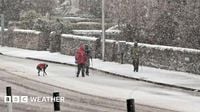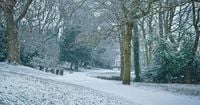Britain is bracing for a dramatic shift in weather as a powerful blast of Arctic air sweeps across the country, plunging temperatures well below the seasonal average and prompting a series of severe weather and health warnings. According to the Met Office and the UK Health Security Agency (UKHSA), this cold snap, which began on Monday, November 17, 2025, is set to bring widespread frost, icy roads, and significant snowfall to large swathes of Scotland and northern England—ending what had been an unusually mild start to November.
The UKHSA upgraded its cold weather alert to amber on Monday, signaling that the North East, North West, and Yorkshire and the Humber face a heightened risk of serious impacts on health and social care services. Yellow weather warnings for ice and snow were issued for much of the rest of England, with all alerts set to remain in effect until at least Friday morning. The Met Office warned that overnight temperatures could plummet to -10°C, with the coldest conditions expected mid-week. For those in rural Scotland, the mercury could fall even further, with forecasts suggesting lows of -12°C on Thursday night.
"Wednesday to Friday will be the coldest part of the week, and this period has the greatest potential for impactful weather, with multiple warnings in place," explained Met Office deputy chief forecaster Tom Crabtree. "Overnight, temperatures could get down to minus 10C, with a significant wind chill from the strong northerly wind making things feel even colder."
The sudden arrival of Arctic air marks a stark reversal from the first half of November, when the UK basked in temperatures 3-6°C above average. Now, those same regions are experiencing temperatures 3-6°C below the mid-November norm, with biting winds making it feel even colder. The Met Office has issued a series of yellow severe weather warnings for snow and ice, particularly for Scotland and northern England, with additional alerts for the Midlands.
From Monday evening, yellow ice warnings took effect in the North East and far north of mainland Scotland, lasting until Tuesday morning. A snow warning was announced from 3am to 6pm on Tuesday, November 18, covering Central, Tayside and Fife, Grampian, Highlands and Eilean Siar, and Strathclyde. Further ice warnings were issued for parts of northern England from 5am to midday on Tuesday. The Met Office forecasted that from Wednesday through Friday, the risk of impactful weather would be highest, with multiple warnings for snow and ice extending into Thursday for north-east England, south-west Scotland, Yorkshire and Humber, and northern Scotland.
Snowfall is expected to be widespread, with the Met Office predicting 2-5cm at low levels and up to 15-20cm above 300m in northern Scotland. Even lower-lying areas could see significant accumulation, particularly in northern and eastern Scotland, where a yellow weather warning for snow is in place from 3am to 6pm on Tuesday. The highest ground could see as much as 5-10cm of snow, potentially rendering some routes impassable and causing disruption to rail journeys. During Tuesday, hill snow is also anticipated in the North Pennines and the North York Moors.
Frequent and heavy snow showers are forecast to continue in northern Scotland from Tuesday night through Thursday, with the added risk of gusty winds and even lightning—phenomena known as 'thundersnow.' The cold northerly wind on Wednesday is expected to blow snow showers across not just northern Scotland, but also Northern Ireland, eastern England, west Wales, and even the Moors of south-west England. Additional yellow warnings for snow and ice are in force for coastal areas of eastern England from Wednesday morning until Thursday evening, with some areas bracing for 2-5cm at low levels and up to 20cm over hills above 300m.
As temperatures fall below freezing overnight, the risk of ice increases, with untreated roads and pavements likely to become treacherous. The Met Office cautioned that travel delays on roads are likely, and some vehicles could become stranded. "The possibility that paths which haven’t been treated, ie with grit or salt, might become unpassable to cyclists and pedestrians," was emphasized in a recent weather advisory. There is also an increased likelihood of falls and slips due to ice, potential power cuts, and a higher risk of service disruptions, including phone signal issues. Certain rural communities face the risk of being temporarily cut off, and public transport services—buses and trains—could see delays or cancellations.
The UKHSA's amber cold health alert highlights the potential for significant impacts on health and social care, particularly among vulnerable populations. The agency warned that the cold weather could lead to excess deaths, especially among those over 65 or with pre-existing health conditions, but younger age groups may also be affected. Extra demand on health and social care services is expected as the cold snap continues.
For those living in affected areas, the Met Office offered practical advice: plan journeys in advance, allow extra time to avoid rushing, and use main roads that are more likely to be treated with grit or salt. Drivers are encouraged to carry warm clothing, food, water, a blanket, a torch, an ice scraper, a warning triangle, a high-visibility vest, and an in-car phone charger. Households are advised to prepare for possible power outages by keeping torches, batteries, and other essentials on hand. Above all, staying up to date with the latest weather warnings is crucial.
The UK recorded its coldest night since March on Saturday, November 15, 2025, with temperatures dropping to -7°C in Tulloch Bridge in the Highlands. As the week progresses, daytime temperatures are expected to hover between 2-5°C, but with the wind chill, it will feel more like -2 to -4°C. Thursday night is forecast to be the coldest, with rural Scotland possibly dipping to -12°C. However, by Friday, there are signs of a shift as an Atlantic weather system moves in from the west, bringing more cloud, some rain, and slightly milder air. By Saturday, temperatures are expected to return to average levels, though the respite may be short-lived as winter tightens its grip.
Yellow weather warnings, the mildest issued by the Met Office, indicate a low probability but medium impact of disruptive weather. They serve as an early heads-up for the public to stay alert and adapt their plans. Amber warnings, meanwhile, denote a higher risk and likelihood of significant disruption—especially to health and social care services. The Met Office urges everyone to read the content of weather warnings carefully, as the severity and likelihood of impacts can vary even within the same color-coded alert.
For now, the message is clear: bundle up, stay informed, and be prepared for challenging conditions as the UK weathers its first major cold snap of the season. The coming days will test both infrastructure and resilience, but with timely warnings and community vigilance, the nation is better equipped to handle whatever winter throws its way.






